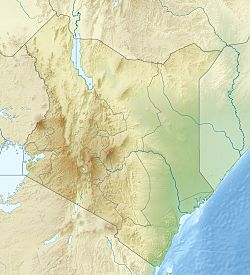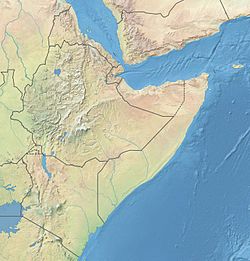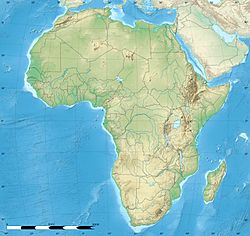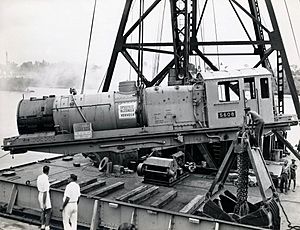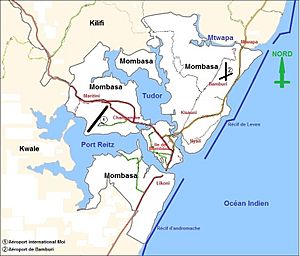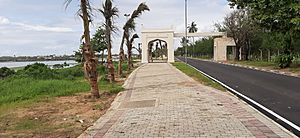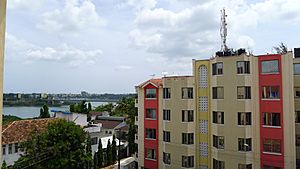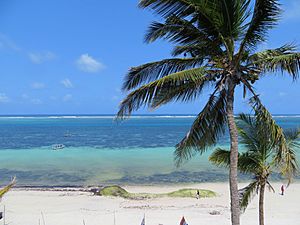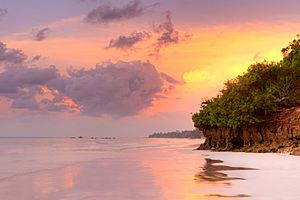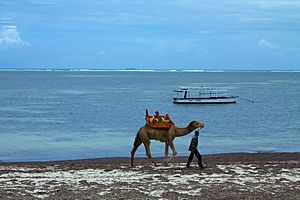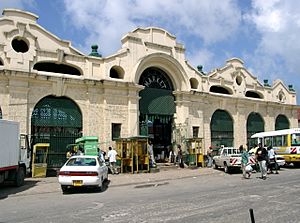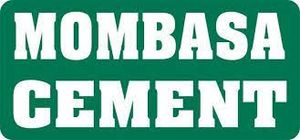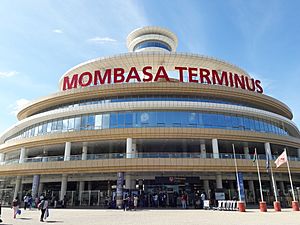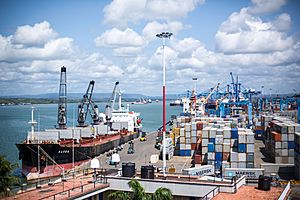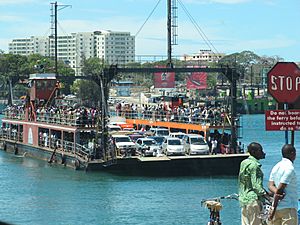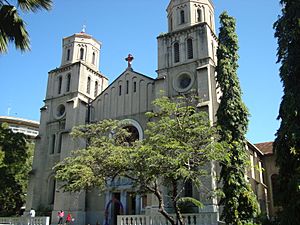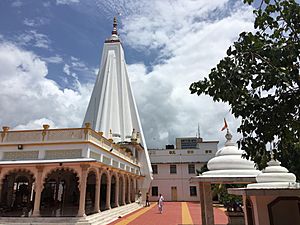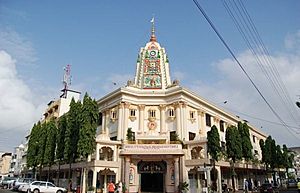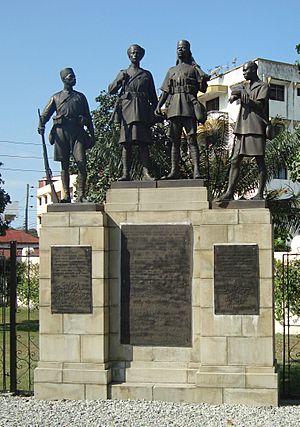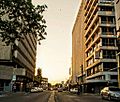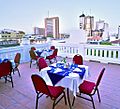Mombasa facts for kids
Quick facts for kids
Mombasa
|
|
|---|---|
|
City and city county
|
|
|
Clockwise from top: Mombasa Island, Rooftop restaurant near KPLC offices, a roundabout at Moi Avenue, Sunset in the CBD.
|
|
Nicknames:
|
|
| Country | |
| County | Mombasa County |
| Founded | 900 A.D. |
| Government | |
| • Type | County Government |
| • Body | County Assembly |
| Area | |
| • Land | 219.9 km2 (84.9 sq mi) |
| Elevation | 50 m (160 ft) |
| Population
(2019)
|
|
| • Urban | 1,208,333 |
| • Metro | 3,528,940 |
| Demonym(s) | mombasanese |
| Time zone | UTC+3 (EAT) |
| Area code(s) | 020 |
| GDP (2018) | US$7.2 billion (Mombasa Metro GDP) |
Mombasa (mom-BASS-ə) is a busy city on the coast of southeastern Kenya. It sits right along the Indian Ocean. It was once the first capital of British East Africa. Later, Nairobi became the capital in 1907. Today, Mombasa is the main city of Mombasa County.
People in Kenya often call Mombasa "the white and blue city." It is Kenya's oldest city, founded around 900 A.D. It is also the second-largest city after Nairobi. In 2019, about 1.2 million people lived there. Its larger metropolitan area has about 3.5 million people.
Mombasa's great location on the Indian Ocean made it a very important trading hub for a long time. Many countries wanted to control it because of this. History books in Kenya say Mombasa was founded around 900 A.D. An Arab geographer named al-Idrisi wrote about it in 1151. This shows it was already a busy trading town by then.
The oldest stone mosque in Mombasa, called Mnara, was built around 1300. Another mosque, Mandhry, built in 1570, has a special arch design. This shows that local African builders created their own unique styles.
Today, Mombasa is a popular place for tourists. It has one of Kenya's state houses. It also has a very large port and an international airport.
Contents
History of Mombasa
Sultan of Mombasa Before 1593
![]() Portuguese Empire 1593–1698
Portuguese Empire 1593–1698
![]() Imamate of Oman 1698–1728
Imamate of Oman 1698–1728
![]() Portuguese Empire 1728–1729
Portuguese Empire 1728–1729
![]() Imamate of Oman 1729–1824
Imamate of Oman 1729–1824
![]() British Empire 1824–1826
British Empire 1824–1826
![]() Sultanate of Muscat and Oman 1826–1887
Sultanate of Muscat and Oman 1826–1887
![]() British East Africa/Kenya 1887–1963
British East Africa/Kenya 1887–1963
![]() Kenya 1963–present
Kenya 1963–present
Early Beginnings and Trade
The story of Mombasa's founding involves two important leaders: Mwana Mkisi and Shehe Mvita. Legend says Mwana Mkisi was a queen from before Islam arrived. She founded Kongowea, the first town on Mombasa Island. Families linked to the "Twelve Nations" are still seen as the original people of the city.
The names of the queen and the city have links to Central Africa. "Mkisi" means "the holy" in the kiKongo language. "Kongowea" is like the Swahili word for "kongo," which means order. These stories show the Swahili people came from Bantu-speaking groups.
Shehe Mvita came after Mwana Mkisi. He built the first lasting stone mosque on Mombasa Island. The oldest stone mosque still standing, Mnara, was built around 1300. Shehe Mvita was known as a very smart Muslim. He is linked to the Swahili culture that Mombasa is known for today.
Much of what we know about early Mombasa comes from Portuguese writers in the 1500s. The famous traveler Ibn Battuta visited the area in the 1300s. He noted that the people of Mombasa were good Muslims. Their mosques were made of wood and built very well.
Mombasa was a key place for trading spices, gold, and ivory. Its trade routes reached as far as India and China. Local storytellers still share tales from this time. Mombasa was the main port city of pre-colonial Kenya in the Middle Ages. It traded with other African cities, the Persian Empire, Arabia, India, and China.
Portuguese Control
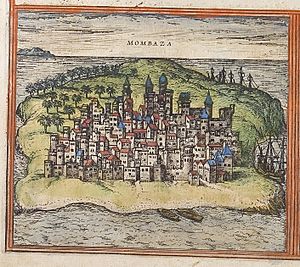
Vasco da Gama was the first European to visit Mombasa in 1498. He did not get a warm welcome. Two years later, the Portuguese attacked the town. In 1502, Mombasa became independent from Kilwa Kisiwani.
The Portuguese had many fights with the city. They attacked it in 1505 and again in 1528. In 1585, the Ottoman Empire took Mombasa from the Portuguese. But then the Portuguese took it back in 1589. Four years later, they built Fort Jesus to control the area.
After Fort Jesus was built, the Portuguese put members of Malindi's ruling family in charge. In 1631, Dom Jeronimo, the ruler of Mombasa, killed the Portuguese soldiers there. He defeated the Portuguese army sent to help. In 1632, Dom Jeronimo left Mombasa and became a pirate. That year, the Portuguese came back and ruled Mombasa directly.
Omani and British Rule
In 1698, the Imamate of Oman took over Fort Jesus. This brought Mombasa under Omani influence. The Omani rulers appointed governors, but there were often local rebellions. Mombasa was briefly under Portuguese rule again from 1728 to 1729. Then, it went back to Omani control.
From 1824 to 1826, the British Empire had a protectorate over Mombasa. This meant Britain offered protection but did not fully rule. Omani rule returned in 1826. In 1837, the Sultan of Muscat and Oman officially took over Mombasa.
On May 25, 1887, Mombasa was given to the British East Africa Association. It later became the Imperial British East Africa Company. In 1895, it came under full British control.
Mombasa soon became the capital of the British East Africa Protectorate. It was also the starting point for the Uganda Railway. Building the railway began in 1896. Many workers from British India came to build it. This helped the city grow again. The Sultan of Zanzibar officially gave the town to the British in 1898.
Mombasa was the capital of the Kenya Colony Protectorate of Kenya until around 1906. Doctors warned that the ground was swampy and unhealthy. So, the capital was moved to Nairobi. Nairobi has been Kenya's capital ever since.
The Mombasa tusks are famous monuments in the city. They were built in 1952 by the British. They honored the visit of Queen Elizabeth II to Mombasa.
In 2018, Mombasa's governor wanted to attract more tourists. He ordered all buildings in the Old Town to be painted white with blue trim. He also banned signs from walls. The city wanted to be "the most photographed in Africa."
Geography and Climate
Mombasa is a coastal town with mostly flat land. The main part of Mombasa is on Mombasa Island. But the city also spreads onto the mainland. Two creeks, Port Reitz and Tudor Creek, separate the island from the mainland.
Weather in Mombasa
Mombasa has a tropical wet and dry climate. This means it has a hot, wet season and a hot, dry season. Most rain falls in April and May. January and February are the driest months.
Because Mombasa is near the equator, its temperature does not change much. High temperatures usually range from 28.8 to 33.7 degrees Celsius (83.8 to 92.7 degrees Fahrenheit).
As a seaport, Mombasa is affected by changes in climate. In October 2006, a big flood hit Mombasa. It affected 60,000 people. Like the rest of Kenya, Mombasa faces challenges from climate change. The coastline is eroding because of rising sea levels. This means the land is washing away at about 2.5 to 20 centimeters (1 to 8 inches) each year. This has also led to more floods every year.
| Climate data for Mombasa (1961–1990, extremes 1890–present) | |||||||||||||
|---|---|---|---|---|---|---|---|---|---|---|---|---|---|
| Month | Jan | Feb | Mar | Apr | May | Jun | Jul | Aug | Sep | Oct | Nov | Dec | Year |
| Record high °C (°F) | 41.4 (106.5) |
45.9 (114.6) |
43.0 (109.4) |
41.4 (106.5) |
35.0 (95.0) |
33.4 (92.1) |
31.0 (87.8) |
30.3 (86.5) |
31.6 (88.9) |
33.0 (91.4) |
35.9 (96.6) |
37.3 (99.1) |
45.9 (114.6) |
| Mean daily maximum °C (°F) | 33.2 (91.8) |
33.7 (92.7) |
33.7 (92.7) |
32.5 (90.5) |
30.9 (87.6) |
29.4 (84.9) |
28.7 (83.7) |
28.8 (83.8) |
29.7 (85.5) |
30.5 (86.9) |
31.6 (88.9) |
32.8 (91.0) |
31.3 (88.3) |
| Daily mean °C (°F) | 27.6 (81.7) |
28.1 (82.6) |
28.3 (82.9) |
27.6 (81.7) |
26.2 (79.2) |
24.8 (76.6) |
24.0 (75.2) |
24.0 (75.2) |
24.7 (76.5) |
25.7 (78.3) |
26.9 (80.4) |
27.4 (81.3) |
26.3 (79.3) |
| Mean daily minimum °C (°F) | 22.0 (71.6) |
22.5 (72.5) |
22.9 (73.2) |
22.7 (72.9) |
21.6 (70.9) |
20.1 (68.2) |
19.3 (66.7) |
19.3 (66.7) |
19.7 (67.5) |
20.9 (69.6) |
22.1 (71.8) |
22.0 (71.6) |
21.3 (70.3) |
| Record low °C (°F) | 16.8 (62.2) |
19.4 (66.9) |
19.7 (67.5) |
18.9 (66.0) |
18.8 (65.8) |
17.4 (63.3) |
13.6 (56.5) |
15.3 (59.5) |
16.3 (61.3) |
18.0 (64.4) |
18.8 (65.8) |
18.1 (64.6) |
13.6 (56.5) |
| Average precipitation mm (inches) | 33.9 (1.33) |
14.0 (0.55) |
55.6 (2.19) |
154.3 (6.07) |
235.5 (9.27) |
88.3 (3.48) |
71.8 (2.83) |
68.2 (2.69) |
67.2 (2.65) |
103.4 (4.07) |
104.7 (4.12) |
75.8 (2.98) |
1,072.7 (42.23) |
| Average precipitation days (≥ 1.0 mm) | 3 | 1 | 5 | 10 | 14 | 10 | 10 | 8 | 9 | 9 | 8 | 7 | 94 |
| Average relative humidity (%) | 77 | 75 | 77 | 80 | 82 | 82 | 82 | 82 | 80 | 81 | 82 | 80 | 80 |
| Mean monthly sunshine hours | 269.7 | 254.8 | 269.7 | 225.0 | 204.6 | 207.0 | 210.8 | 244.9 | 246.0 | 272.8 | 264.0 | 260.4 | 2,929.7 |
| Mean daily sunshine hours | 8.7 | 9.1 | 8.7 | 7.5 | 6.6 | 6.9 | 6.8 | 7.9 | 8.2 | 8.8 | 8.8 | 8.4 | 8.0 |
| Source 1: NOAA | |||||||||||||
| Source 2: Deutscher Wetterdienst (humidity, 1962–1993), Meteo Climat (record highs and lows) | |||||||||||||
Mombasa's Neighborhoods
Mombasa is on an island and also spreads onto the mainland. The island is connected to the north by the Nyali Bridge. To the south, the Likoni Ferry connects it to the mainland. To the west, the Makupa Causeway links it to the mainland. This is also where the Kenya-Uganda Railway runs. The city has Moi International Airport in the northwest suburb of Chaani.
Mombasa Island Areas
- Kizingo: This is a fancy residential area. Important buildings like the State House and Law Courts are here. Many schools are also in Kizingo.
- Central Business District (CBD): This area is very busy with many people. It has government offices and big businesses like banks and audit firms.
- Kibokoni: This is part of the Old Town. It has beautiful Swahili architecture. Fort Jesus is located here.
- Kuze: Another part of the Old Town known for its Swahili culture. It used to be mainly Swahili people, but now many different groups live here.
- Makadara: This Old Town area has many people whose ancestors were Baluchi soldiers.
- Ganjoni: A middle-class neighborhood. It has Africa's second-largest dry dock.
- Tudor: Another middle-class area with homes and shops. The Technical University of Mombasa is located here.
North Coast Areas
- Nyali: This is a fancy residential area north of the island. It is connected by the New Nyali Bridge. Many hotels are along the beach here. Nyali has two parts: Old Nyali and New Nyali. It has shopping malls, cinemas, banks, and schools.
- Kongowea: A very crowded area with many villages. Many people from the mainland moved here to find jobs. They often work in Nyali as guards, gardeners, or house helpers. Kongowea also has one of the biggest open-air markets in East Africa.
- Bamburi: This town is a short drive from Mombasa. It has the Bamburi Cement factory, which is the largest in East Africa. The Jomo Kenyatta public beach (Pirates) and Haller Park (a wildlife park) are also here.
- Other areas include Shanzu, Mkomani, Bombolulu, Kisauni, and Mtwapa. The North Coast is known for its fun entertainment and nightlife for both locals and tourists.
South Coast Areas
- Likoni: This is a neighborhood with lower and middle-income homes. It is connected to Mombasa Island by a ferry. The Liwatoni Pedestrian Floating Bridge was built to help people cross easily.
- Diani Beach: This is a famous beach resort area south of Mombasa. It is about 36 kilometers (22 miles) from the city. Many local and international tourists visit Diani Beach. It has an airport in Ukunda for direct flights from Nairobi.
Mombasa Mainland Areas
- Magongo: This town is northwest of Mombasa Island. It is on the highway to Nairobi. This area has less infrastructure like electricity and water. Poverty and unemployment are big problems here. Many people work in Mombasa Island. Magongo is home to the Akamba Handicraft Cooperative.
- Mikindani: A suburban area on the mainland, also along the Nairobi Highway. It is near industrial areas like Changamwe. Many working-class people live here.
- Miritini: A fast-growing suburban town on the Mombasa Nairobi Highway.
- Changamwe: An industrial area with power plants and the Kenya Oil Refinery. It is also the way to Moi International Airport.
- Migadini & Chaani: These are two neighborhoods east of the Airport road and the Kenya Port Authority.
- Port Reitz: A suburb on the mainland with a beach and oil refineries. Moi International Airport and the Port Reitz District Hospital are in Port Reitz.
People of Mombasa
Mombasa city had about 1.2 million people in 2019. It has a mix of many different people. The Swahili people and Mijikenda are the largest groups. Other communities include the Akamba and Taita Bantus. There are also many Luo and Luhya people.
The main religions in Mombasa are Christianity and Islam. Over many years, immigrants and traders have settled in Mombasa. Many came from the Middle East.
| Historical population | ||
|---|---|---|
| Year | Pop. | ±% |
| 1969 | 247,073 | — |
| 1979 | 341,148 | +38.1% |
| 1989 | 461,753 | +35.4% |
| 1999 | 665,018 | +44.0% |
| 2009 | 939,370 | +41.3% |
| 2019 | 1,208,333 | +28.6% |
| source: | ||
Religion in Mombasa
Religion in Mombasa County (2019 census) Islam (37.3%) Christianity (56.4%) Other (7.3%)
Economy and Jobs
Mombasa is a very important economic center in Kenya. Besides trading coffee, it has food and chemical industries. There is also a steel mill, an aluminum factory, an oil refinery, and a cement plant.
The city has the most important seaport in East Africa, called Kilindini Harbour. This port is also used by nearby countries like Tanzania and Uganda for their goods. Kilindini is an old Swahili word meaning "deep." The port is naturally very deep because it was formed when the sea level rose and filled a river valley.
Mombasa is a big center for tourism in Kenya. While Mombasa Island itself is not the main attraction, many people visit the Old Town and Fort Jesus. The beaches north of the city, like Nyali, Bamburi, and Shanzu, are very popular. South of Mombasa, you can find Shelly, Tiwi, and Diani beaches. These beaches have many luxury hotels.
Mombasa's northern coast is known for its lively entertainment. It has water parks, cinemas, bowling, and many restaurants. You can find food from Kenya, China, India, Italy, and other countries. The nightlife with bars and clubs is also very active.
Other important industries include an oil refinery and a cement factory. Big undersea internet cables reach shore near Mombasa. This helps connect East Africa to the rest of the world. It also supports a growing call centre business.
Mombasa is becoming a Special Economic Zone (SEZ). This means certain industries, like tea and clothing, will not have to pay some taxes. This helps local businesses grow.
The youth unemployment rate in Mombasa is 44%. This is more than double the national average of 21% (in 2016).
Transportation
Air Travel
Moi International Airport is in Mombasa. It is Kenya's second-largest airport. It has daily flights to Nairobi and other places in Kenya, Europe, and the Middle East. The airport also handles a lot of cargo.
Train Travel
Mombasa has a modern train station for the Mombasa–Nairobi Standard Gauge Railway. This new railway replaced the older Uganda Railway built in 1901. The new station, called Mombasa Terminus, was finished in 2017. It connects Mombasa to Nairobi. The station is about 20 kilometers (12 miles) from the city center. A new highway, built in 2018, makes it easy to reach. Kenya Railways uses this railway for both passengers and cargo.
Road Travel
Driving in Mombasa is quite easy, and most roads are paved. The Mombasa–Nairobi Expressway connects Mombasa to the capital city, Nairobi.
Within Mombasa, most local people use matatus. These are mini-buses that are very common in Kenya. They help people move around the city and its suburbs. The tuk-tuk, a three-wheeled vehicle, is also widely used. It can carry up to three passengers. A boda-boda is a motorcycle taxi.
Sea Travel
The port of Mombasa is the largest in East Africa. It has many deep water berths and two oil terminals. The port is connected to the inland areas by train and road. There are not many regular passenger services from the port. However, international cruise ships often visit. The port is part of the 21st Century Maritime Silk Road. This is a big trade route from China to Europe. China has been helping Kenya build roads and railways as part of this project.
Ferry Services
There is no bridge directly connecting Mombasa Island to the south coast. Instead, ferries operated by the Kenya Ferry Service carry people and vehicles. These ferries run from Kilindini and Mtongwe to Likoni on the south coast. A major accident happened in 1994 when a ferry sank, and many people died.
Because of more luxury hotels on the south coast, tourists can now fly directly from Nairobi to Ukunda. This airstrip is on the south coast.
The Dongo Kundu Bypass Highway is being built. It will have three bridges and will connect the mainland to the south coast. This will reduce the need for the ferry services. The Mombasa Gate Bridge will connect the mainland to Likoni. This will make travel safer and easier.
Education in Mombasa
The main university on Mombasa Island is the Technical University of Mombasa. The city also has a campus of Kenyatta University. Other university campuses include:
- University of Nairobi-Mombasa campus
- Mount Kenya University-Mombasa campus
- JKUAT-Mombasa
There are also colleges like Shanzu Teachers Training College, Mombasa Technical College, Bandari College, Utalii College, and ICS College Mombasa.
International schools in Mombasa follow either the British (IGCSE) or USA curriculum. These include:
- Shree Swaminarayan Academy
- Aga Khan
- Mombasa Academy
- Coast Academy
- Oshwal Academy
These schools teach in English. Their final exams for high school come from the USA or England.
Places of Worship
Mombasa has many places of worship for its diverse communities. Christian churches include:
- Roman Catholic Archdiocese of Mombasa (with Holy Ghost Cathedral)
- Anglican Church of Kenya (with Mombasa Anglican Cathedral Church)
- Presbyterian Church of East Africa
- Baptist Convention of Kenya
- Assemblies of God
There are also many Hindu temples and Muslim mosques. Many Hindus visit Mombasa to pray at naturally formed Lingams in the Nyali beach Gombeshwar Caves. Local stories say the cave-temple was found when a cow kept releasing milk at a certain spot. People dug there and found a 'Shiva Lingam', which is a symbol of the Hindu God Lord Shiva. Hindus offer milk to the Lingam when they worship Lord Shiva.
Some Hindu Temples in Mombasa are:
- Hindu Union of Mombasa - Shivalaay (Makadara)
- Hindu Union of Mombasa - Gombeshwar (Nyali)
- Shree Ganesha Temple - Nyali
- Shree Ramdev Pir Temple - Nyali
- Shree Dwarikadham Hare Krishna Temple (ISKON) - Nyali
- Shree BAPS Swaminarayan Temple - Mombasa Mainland
- Shree Gayatri Brahm Samaj Temple - Mombasa Mainland
- Shree Cutch Satsang Swaminarayan Temple - Mombasa Mainland
- Shree Radhe-Krishna Makupa Temple - Mombasa Mainland
- Shree Vishwakarma Temple - Mombasa Mainland
Other temples include the Sikh Shree Guru Gobind Singh Sabha Temple and the Shree Parshva Vallabh Jain Temple.
Culture and Entertainment
Mombasa is a major cultural center in Kenya. Its closeness to Zanzibar, Nairobi, and India, along with its large shipping industry, gives it a rich mix of cultures. Music is a very important part of Mombasa's culture.
Music Scene
Taarab music, which comes from Zanzibar, is very popular here. Music styles native to Mombasa include the smooth Bango, the fast-paced Chakacha, and traditional Mwanzele.
Famous musicians from Mombasa include Mombasa Roots, Safari Sounds, and Them Mushrooms. Great past artists like Fundi Konde and Fadhili Williams also lived or worked here.
Today, hip hop, reggae, soul, blues, salsa, and bhangra (among the Indian community) are popular, especially with young people. Mombasa has a very lively nightlife with many clubs, bars, and restaurants for tourists and locals.
Sports in Mombasa
Mombasa has a football team, Bandari F.C., which plays in the Kenyan Premier League. They play at the Mbaraki Sports Grounds. Other local teams play in lower leagues. The only Mombasa team to win the league was Feisal F.C. in 1965.
There are several cricket teams in Mombasa. The Mombasa Sports Club (MSC) has a ground that hosts international matches. MSC also has a rugby union team that plays in Kenya's top rugby league.
The 2007 IAAF World Cross Country Championships were held in Mombasa. The Mombasa Marathon is run every year. The city also hosts a classic edition of the Safari Rally and a national rally championship round.
Scuba diving is popular in the Mombasa Marine National Park and Reserve. This park is managed by the Kenya Wildlife Service. It is about 8 kilometers (5 miles) long.
Sister Cities
Mombasa is connected with these cities around the world:
 Durban, South Africa (2012)
Durban, South Africa (2012) Guangzhou, China (2018)
Guangzhou, China (2018) Honolulu, United States (2008)
Honolulu, United States (2008) Long Beach, United States (2007)
Long Beach, United States (2007) Seattle, United States (1981)
Seattle, United States (1981)
Famous People from Mombasa
Many important explorers visited Mombasa throughout history. These include Arabs like Al Idrissi (1151) and Ibn Battuta (1330). Portuguese explorers like Vasco da Gama (1498) and Afonso de Albuquerque (1507) also came here.
Some notable people from Mombasa include:
- Abdilatif Abdalla, a writer and professor.
- Karen Blixen, a Danish novelist.
- Timothy R. McClanahan, a marine ecologist who has worked in Mombasa since 1991.
- Swaleh Nguru, a businessman and helper of nature.
- Thomas Risley Odhiambo, an expert on insects.
- Ayub Ogada, a musician and composer.
- Fadhili William, a musician and composer.
Images for kids
See also
 In Spanish: Mombasa para niños
In Spanish: Mombasa para niños






